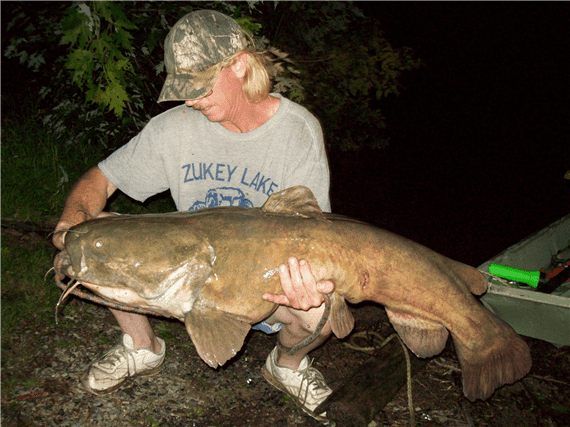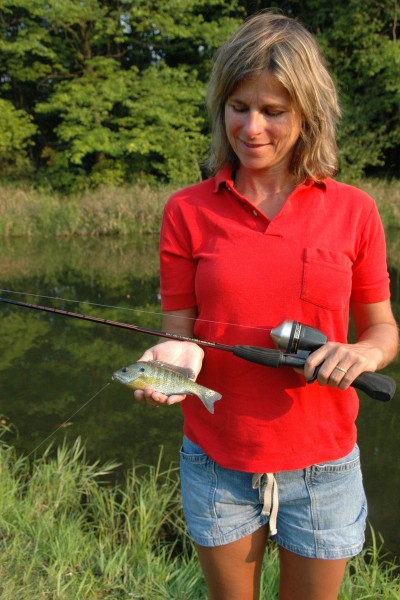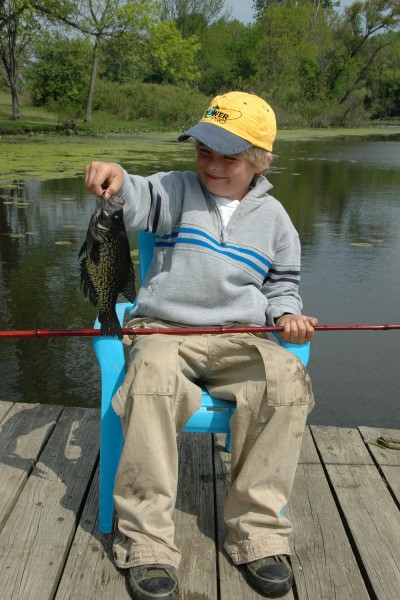How to Beat the Shore-bound Blues
Dan Armitage 12.10.13

“What do you need to be able to go fishing?” is the question I use to kick off a basic fishing seminar I teach at sport shows across the nation each year. I keep the dialogue flowing by accepting the obvious answers, which include “a fishing pole!” and “a hook!” and “some line!” Things come to an abrupt halt, however, when someone fields my question with the reply: “a boat!”
I explain that not only is a boat not required to go fishing, but that many more people fish from shore than from watercraft. I also cite a study conducted for the US Fish and Wildlife Service that showed that children who had their first fishing experience from boats were less likely to fish again than children who were exposed to angling from the shore. It seems that the kids who first fished from a boat, from that point on, figured you needed a boat to go fishing. For those children, unless a watercraft is available, fishing isn’t considered an option.
Bank fishermen know better, and anglers who prefer to keep their feet planted firmly on the shore have developed techniques to tempt just about every species that swims—at least those that swim within range of their casts.
The benefits of being shore-bound
While it’s true that gamefish that spend most of their time in deep water or offshore, including walleye and lake trout in freshwater and saltwater species like dolphin and tuna, are primarily targets for boaters, most popular gamefish, at one time or another, can be caught from the shore. Walleye, for example, make near-shore runs early and late in the season before heading offshore during the summer and winter, and provide great action for anglers who wade tributaries or cast baits from the shoreline. Along the coasts, open water species like king mackerel make near-shore migrations that bring them within range of piers where landlocked anglers get the chance to tangle with typically offshore gamefish like mackerel and cobia.

The majority of gamefish, however, actually frequent near-shore areas, where they find their preferred habitat, which includes both bait for food and cover for protection. In most waters, including lakes, ponds, rivers, and man-made impoundments, the majority of the structure that fish find appealing is located along the shoreline, well within range of a 40-foot cast.
Crappies, for example, seek out brushy areas much of the year, and where better to find submerged trees and brush than near the shore? Walleyes, saugeye, smallmouth bass, and trout are drawn to rocky or graveled areas, and the rip-rap along dams and causeways cater to those preferences while putting the fish within easy range of casts from shore. Largemouth bass and sunfish thrive in shallow weeds, a preference that puts them within easy worm-dunking distance of shore anglers using everything from cane poles to fly rods.
In rivers and streams, boat-less anglers can take the action to the fish by wading and working pools and riffles. Shore anglers make rivers’ water movement work to bring the fish to them, using fragrant baits that emit a scent for fish to find and follow up on from downstream to the designated fishing area. Saltwater anglers us the same tactic, suspending chum into tidal currents to draw fish to their baits suspended from bridges and piers.
Tackle for the shore-bound
Any type of tackle may be used to fish from the shore, and often the simpler the better. Bamboo cane poles are classic bank fishing tackle, especially throughout the Southeast, and have taken more sunfish from the shore than all other tackle types combined. Simple spincasting rigs are perhaps the most popular rod and reel combinations used by shore fishermen. The trigger-and-push-button combos are inexpensive to buy, easy to use and maintain, and are delicate enough to cast fragile natural baits like minnows and worms, yet can handle medium-sized artificial lures such as jigs and crankbaits.
Spinning gear is popular with land-bound fishermen too, especially anglers who are using live bait or casting small artificials like spinners and light jigs for crappie, perch, and trout. Baitcasting tackle makes great gear for casting larger artificial lures to near-shore gamefish like bass and pike in freshwater, or snook, snappers, and sea trout in the salt. All three classes of tackle are good for bottom-fishing, using live, natural, or prepared baits for catfish, hybrid-striped bass, perch, snappers, and other bottom dwellers.
To be prepared for a variety of common shore fishing situations, you need only a basic assortment of tackle. A reel spooled with 10-pound-test monofilament line is capable of catching 80 percent of the freshwater fish, and most of the saltwater fish you are likely to encounter near-shore, yet is small enough in diameter not to spook finicky fish in clear water situations. Hooks to match your quarry are required, and a selection of sizes from #8 to #1/0 for fresh water, and #6 to #2/0 for saltwater, will cover most fishing situations when live, natural, prepared, or strip baits are used.
Lure size should match your target too. Jigs are universally popular and will catch just about anything that swims, so an assortment of sizes from 1/16-ounce for crappie and small trout to 3/8-ounce for walleye, bass, larger trout, salmon, pike, and saltwater species will keep you covered in most situations. Always take more jig heads than you think you’ll need, for if you’re fishing them correctly, you’ll be snagging brush and bottom and losing a few. Match the jig heads with the correct-size plastic grubs in a variety of colors, with black, white, and chartreuse being popular standbys.

Any artificial bait you can use from a boat will work from shore. Crankbaits, spinnerbaits, spoons, and poppers all have their place in the shore fisherman’s tacklebox.
Bobbers are used for suspending live baits up off the bottom or out of the weeds, and a selection of round and pencil-shaped, spring-loaded, snap-on bobbers will come in handy. Pinch-on sinkers, also called split-shot, in 1/16- to 3/8-ounce sizes will allow you to add casting and sinking weight to your baits. Egg sinkers in weights of 1/4- to 1/2-ounce that you thread onto your line will be needed for bottom fishing, especially in areas with current. The sinkers will give you weight for casting, sinking, and holding your baits on the bottom.
Bank fishing techniques
Shore anglers can employ just about any popular fishing technique other than trolling. And I’ve even seen bridge fishermen try that, by holding their rod over the edge of the bridge and walking, riding a bike, or, in low traffic situations, sitting on the hood of a slow-moving car to keep their bait moving through the water below.
Based on how aggressively they go about their angling, bank fishermen fall into one of two major categories: those who stay put and those who are constantly on the move. Many anglers using live bait will stay in one place, with their offerings suspended from bobbers or placed on the bottom, waiting for the fish to come to them. Anglers who use artificial baits are more likely to be mobile, working specific areas of water and then moving on to the next fishing spot, but some aggressive bait anglers use “run and gun” tactics too.
To cover the most water, shore anglers often use a technique called “fan casting.”
To fan cast, you step to bank and make your first cast parallel to the bank to your left or right, dropping your lure close to the water’s edge. Each successive cast is made a little further out from the shoreline, perhaps by one- or two-foot increments, until the angler completes an arc and is casting parallel to the shore on the opposite side from his he started. Viewed from above, the casting pattern would resemble a half-circle, or fan shape, hence the name. Once the half-circle has been completed, the angler will walk a few steps to the right or left—in whichever direction he or she intends to head during the course of their fishing—and repeat the fan-casting process. The technique covers the maximum amount of water available to the shore fisherman and can be highly effective in locating and catching fish.
Gearing up for shore fishing
Other than rod, reel, terminal tackle, lures, and baits, gear that will come in handy during a shore fishing expedition includes a pair of needle-nose pliers with wire cutters; the latter for cutting hooks that are embedded where they shouldn’t be and the former for removing hooks from fish. If you’re planning on fishing in the same location along the shore for very long, you’ll want something to sit on for those waits between bites. A common five-gallon pail is a popular item among bank fishermen, who use them for carrying bait and tackle, as a back-up for a forgotten minnow bucket and, inverted, as a seat. If you plan to keep your catch to eat, then a stringer, fish basket, or ice chest will be needed, and a net comes in handy for landing fish from the shore. Sunglasses, a cap to keep the sun out of your eyes, foul-weather gear, sunscreen, and insect repellent round out the basic needs of the well-equipped bank fisherman.

